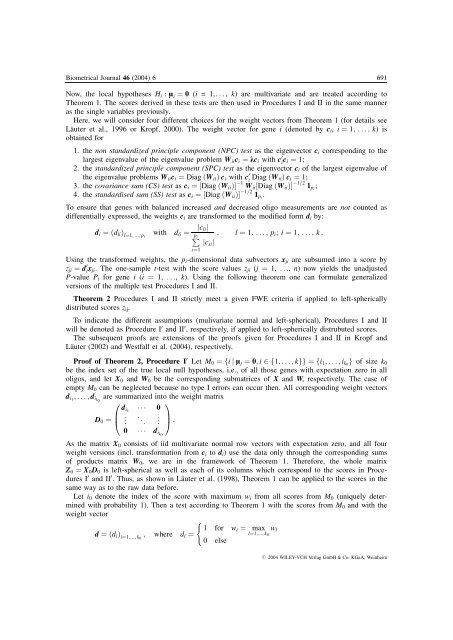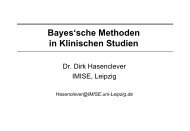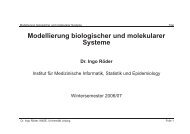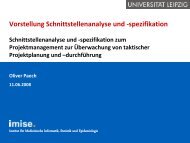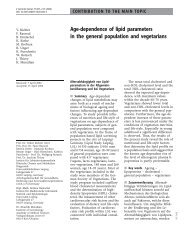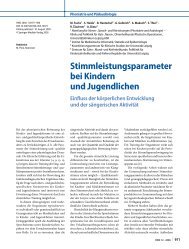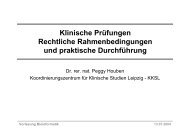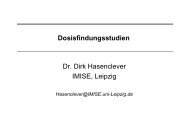Download (200 kB, 12 pages)
Download (200 kB, 12 pages)
Download (200 kB, 12 pages)
Create successful ePaper yourself
Turn your PDF publications into a flip-book with our unique Google optimized e-Paper software.
Biometrical Journal 46 (<strong>200</strong>4) 6 691<br />
Now, the local hypotheses H i : m i ¼ 0 (i = 1,..., k) are multivariate and are treated according to<br />
Theorem 1. The scores derived in these tests are then used in Procedures I and II in the same manner<br />
as the single variables previously.<br />
Here, we will consider four different choices for the weight vectors from Theorem 1 (for details see<br />
Låuter et al., 1996 or Kropf, <strong>200</strong>0). The weight vector for gene i (denoted by c i , i ¼ 1; ...; k) is<br />
obtained for<br />
1. the non standardized principle component (NPC) test as the eigenvector c i corresponding to the<br />
largest eigenvalue of the eigenvalue problem W ii c i ¼ lc i with c 0 i c i ¼ 1;<br />
2. the standardized principle component (SPC) test as the eigenvector c i of the largest eigenvalue of<br />
the eigenvalue problems W ii c i ¼ Diag ðW ii Þ c i with c 0 i Diag ðW iiÞ c i ¼ 1;<br />
3. the covariance sum (CS) test as c i ¼½Diag ðW ii ÞŠ<br />
1 W ii ½Diag ðW ii ÞŠ<br />
1=2 1 pi ;<br />
4. the standardised sum (SS) test as c i ¼½Diag ðW ii ÞŠ<br />
1=2 1 pi :<br />
To ensure that genes with balanced increased and decreased oligo measurements are not counted as<br />
differentially expressed, the weights c i are transformed to the modified form d i by:<br />
d i ¼ðd li Þ l¼1; ...; pi<br />
with d li ¼ jc lij<br />
P p ; l ¼ 1; ...; p<br />
i<br />
i ; i ¼ 1; ...; k :<br />
jc si j<br />
s¼1<br />
Using the transformed weights, the p i -dimensional data subvectors x ji are subsumed into a score by<br />
z ji ¼ d 0 i x ji. The one-sample t-test with the score values z ji (j ¼ 1, ..., n) now yields the unadjusted<br />
P-value P i for gene i (i ¼ 1, ..., k). Using the following theorem one can formulate generalized<br />
versions of the multiple test Procedures I and II.<br />
Theorem 2 Procedures I and II strictly meet a given FWE criteria if applied to left-spherically<br />
distributed scores z ij .<br />
To indicate the different assumptions (mulivariate normal and left-spherical), Procedures I and II<br />
will be denoted as Procedure I 0 and II 0 , respectively, if applied to left-spherically distrubuted scores.<br />
The subsequent proofs are extensions of the proofs given for Procedures I and II in Kropf and<br />
Låuter (<strong>200</strong>2) and Westfall et al. (<strong>200</strong>4), respectively.<br />
Proof of Theorem 2, Procedure I 0 Let M 0 ¼fi j m i ¼ 0; i 2f1; ...; kgg ¼ fi 1 ; ...; i k0 g of size k 0<br />
be the index set of the true local null hypotheses, i.e., of all those genes with expectation zero in all<br />
oligos, and let X 0 and W 0 be the corresponding submatrices of X and W, respectively. The case of<br />
empty M 0 can be neglected because no type I errors can occur then. All corresponding weight vectors<br />
d i1 ; ...; d ik0 are summarized into the weight matrix<br />
0<br />
1<br />
D 0 ¼<br />
B<br />
@<br />
d i1 0<br />
.<br />
.<br />
.<br />
. .<br />
.<br />
.<br />
0 d ik0<br />
C<br />
A :<br />
As the matrix X 0 consists of iid multivariate normal row vectors with expectation zero, and all four<br />
weight versions (incl. transformation from c i to d i ) use the data only through the corresponding sums<br />
of products matrix W 0 , we are in the framework of Theorem 1. Therefore, the whole matrix<br />
Z 0 ¼ X 0 D 0 is left-spherical as well as each of its columns which correspond to the scores in Procedures<br />
I 0 and II 0 . Thus, as shown in Låuter et al. (1998), Theorem 1 can be applied to the scores in the<br />
same way as to the raw data before.<br />
Let i 0 denote the index of the score with maximum w i from all scores from M 0 (uniquely determined<br />
with probability 1). Then a test according to Theorem 1 with the scores from M 0 and with the<br />
weight vector<br />
(<br />
d ¼ðd i Þ i¼1;...; k0<br />
; where d i ¼ 1 for w i ¼ max w l<br />
l¼1;...; k 0<br />
0 else<br />
# <strong>200</strong>4 WILEY-VCH Verlag GmbH & Co. KGaA, Weinheim


